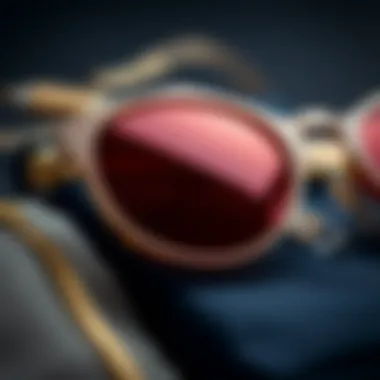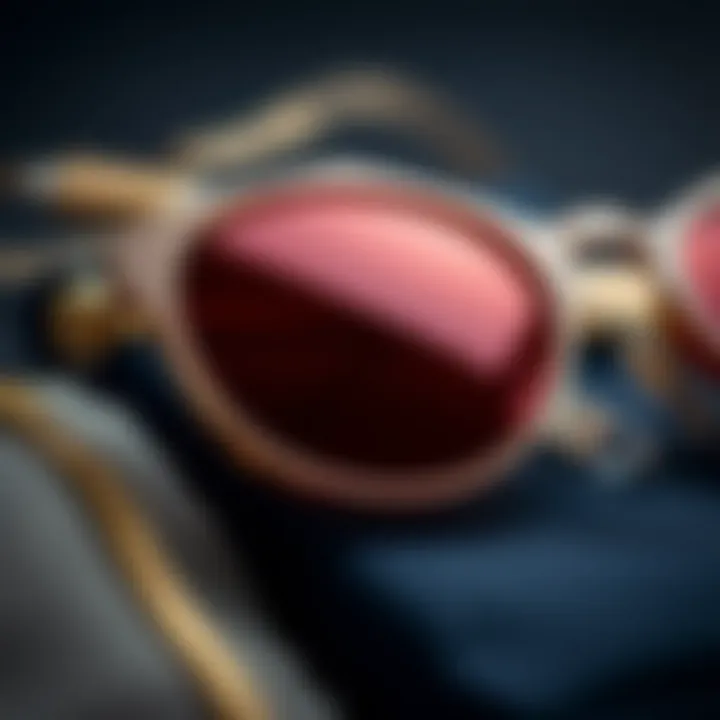Geometric Aviator Sunglasses: Style Meets Function


Intro
The world of sunglasses has seen countless trends come and go, yet a few styles remain timeless, continuing to capture the essence of modernity and tradition. One such style is the geometric aviator sunglasses, a striking blend of functionality and flair. This article takes a closer look at how these eyeglasses not only serve as a shield against the sun but also as a bold statement piece, reflecting individual identity and social consciousness. For fashion enthusiasts, designers, and consumers alike, understanding the multifaceted nature of these sunglasses is crucial as we navigate the ever-evolving landscape of fashion.
From their humble beginnings as an aviator's utility accessory to their current status as a sought-after fashion staple, geometric aviator sunglasses have undergone a remarkable transformation. Their unique shape and structure cater to diverse tastes while also meeting practical needs. Furthermore, in an era where sustainable fashion is becoming increasingly important, these sunglasses symbolize a shift towards eco-friendly practices and ethical choices.
We'll delve into the latest fashion trends that influence the design and popularity of geometric aviator sunglasses, explore sustainable practices within the industry, and highlight the cultural significance tied to this particular eyewear style. This comprehensive discussion aims to frame geometric aviator sunglasses not just as an accessory, but as an important piece in the puzzle of contemporary fashion.
Prelude to Geometric Aviator Sunglasses
Geometric aviator sunglasses have recently taken center stage in the eyewear world, marrying the tried-and-true aviator silhouette with sharp, modern geometric touches. These shades are more than just a way to shield one’s eyes from the sun; they encapsulate a philosophy where style and functionality coexist beautifully. The significance of this topic lies in how these sunglasses reflect evolving trends in fashion and culture. In a society constantly seeking authenticity, the geometric aviator stands as a representation of both personal flair and practical design.
Definition and Characteristics
At their core, geometric aviator sunglasses retain the classic teardrop shape of traditional aviators but introduce a more angular approach in their design. This means you might see pairs that incorporate hexagonal lenses or even uniquely shaped frames that change how we perceive the classic aviator.
Some essential characteristics include:
- Frame Shape: The use of geometric shapes — think octagons or trapezoids — that typically contrast the softer lines of traditional aviators.
- Lens Color: A variety of lens tints, from vibrant hues to subtle gradients, helps accentuate the geometric style.
- Material Choices: Innovations in materials like lightweight metals or eco-friendly plastics offer durability without sacrificing comfort.
In practical terms, these sunglasses not only serve the aesthetic purpose but also provide sufficient UV protection. Therefore, they function as a statement piece and a necessity, fulfilling the dual role that many consumers are now looking for in accessories.
Historical Context of Aviator Sunglasses
Aviator sunglasses have roots that dive deep into the military history of the 1930s. Originally designed for pilots, these shades became popular due to their practical features — large lenses to enhance visibility and minimize glare. Fast forward several decades, and aviators transitioned into mainstream fashion, becoming a symbol of rebelliousness and coolness, often linked to iconic figures in pop culture.
As tastes evolved in the latter part of the 20th century, the classic aviator design started to see new interpretations. The geometric aviator sunglasses represent the culmination of this evolution, blending nostalgia for the past with a bold leap into the future. In essence, they are a tribute to a long-standing heritage, reimagined through a contemporary lens.
In summary, the introduction to geometric aviator sunglasses sets the stage for a broader exploration of their unique design elements, historical evolution, and pronounced significance in modern fashion. These sunglasses are a keen reflection of how style and utility can coalesce to create something truly remarkable.
Evolution of Geometric Designs
The evolution of geometric designs in eyewear has marked a significant shift in both aesthetics and functionality. This section digs into various strands of these designs, weaving together how they have transformed personal style while adapting to the ever-changing preferences of consumers. Understanding this evolution sheds light on why geometric aviator sunglasses are essential not just as functional objects but also as bold fashion statements.
Trends in Eyewear Design
In recent years, eyewear design has seen a rapid transition. Geometric aviator sunglasses encapsulate this shift. What used to be a simple aviator silhouette has now morphed into an array of shapes—from hexagons to more avant-garde forms like trapezoids. The trend is geared towards uniqueness and individual expression.
Styles that stood out a decade ago appear almost archaic as modern designs challenge conventions. Brands like Ray-Ban and Prada, for example, are leading the pack, pushing the envelope with more eccentric designs. The integration of unexpected angles and bold colors is a response to a market increasingly leaning towards personalized fashion choices.
As eyewear continues to evolve, other trends are also surfacing, reflecting society's shifting values:
- The rise in ethical consumption, where consumers gravitate towards brands with sustainable practices.
- The use of cutting-edge technology in lenses that provide additional functionalities, like adaptive tints.
- Collaborations between luxury fashion designers and eyewear brands, producing limited edition styles that become highly sought-after collectibles.
Influence of Geometry in Fashion
Geometry's role in fashion extends well beyond mere aesthetics; it serves as a platform for innovation. In the 20th century, the clean lines and distinctive angles of geometry influenced not only garment design but also accessories, including eyewear. Designers such as Issey Miyake and Thierry Mugler have long fascinated audiences with geometric forms, merging fashion with visual art.
The current trend of geometric aviator sunglasses draws on this heritage but also applies it to a new age of design thinking. Shapes that evoke emotion and provoke thought become a canvas for brand narratives.
“Fashion is not just about clothes. It's a way to express who you are.” - Anonymous.
The interplay of geometry and fashion is particularly intriguing because it allows for a form of self-expression that resonates with both minimalistic and maximalistic aesthetic lovers. Audiences can choose gear that speaks to their unique identity, allowing them to boldly express their personal stories.


Iconic Styles and Their Impact
Throughout the years, certain geometric aviator styles have earned legendary status. For instance, the classic teardrop aviators, though simplistic at first sight, revolutionized the functionality of sunglasses by balancing style with performance. On the other hand, contemporary iterations, like angular frames featuring an almost futuristic vibe, have emerged as statements of bold fashion.
Consider the impact of brands such as Gucci and Fendi that reimagined aviator sunglasses through geometric frameworks. These brands not only set trends but also defined norms in eyewear, shaping consumer expectations about what sunglasses should look like and represent.
The rise of influencer culture, especially on platforms like Instagram, has accelerated this impact. Every influencer flaunting a pair of geometric aviators can spark a wave of interest and desirability among trends-savvy shoppers. Social media feeds filled with these striking pieces amplify their cultural significance, creating an ‘it’ accessory status that often holds sway in larger fashion circles.
In essence, understanding the evolution of geometric designs in aviator sunglasses offers insights into their deeper meaning within the fashion industry. It's a compelling narrative that ties together consumer behavior, artistic expression, and the future of personal branding.
Materials and Craftsmanship
The realm of geometric aviator sunglasses is diverse, rich, and layered, but nothing speaks to their essence quite like the interplay of materials and craftsmanship. Understanding these elements is crucial for any fashion enthusiast or designer delving into the world of eyewear, as they significantly influence both the function and appeal of these iconic accessories. A thoughtful evaluation of materials used lends insight into durability, style, and ecological considerations. Similarly, the craftsmanship behind each pair reflects not just the aesthetic qualities but also the narrative of contemporary fashion's evolution.
Types of Materials Used
When it comes to geometric aviator sunglasses, materials play a foundational role. The typical choices range from metals to plastics, each bringing its unique charm and benefits.
- Metal Frames: Often made from stainless steel or titanium, metal frames offer a sleek aesthetic while ensuring durability and lightweight comfort. Titanium, in particular, is resistant to corrosion, making it ideal for summer outings by the beach.
- Acetate: This plant-based plastic is widely favored for its versatility and range of colors. It can be molded into various shapes, offering unique looks that resonate with individual styles. The vibrant hues and patterns available in acetate can transform a simple pair of aviators into a personal statement piece.
- Wood and Sustainable Alternatives: Some new designs have started incorporating bamboo or reclaimed wood, appealing to the environmentally conscious consumer. These materials add a rustic touch with an eco-friendly appeal, promoting sustainable fashion practices.
Exploring the materials brings to light various quality aspects and the tactile experiences they afford to the wearer.
Manufacturing Techniques
Craftsmanship goes beyond just the selection of materials; it encompasses the intricacies of manufacturing techniques that define the quality and longevity of the product. Diving into these procedures reveals the meticulous processes that elevate a mere accessory into a work of art.
- Injection Molding: For acetate frames, injection molding is a common manufacturing technique, allowing for precision in design and rapid reproduction. It ensures that each piece is uniform while providing opportunities for additional detailing through various finishing techniques.
- Handcrafted Elements: Some high-end brands opt for handcrafting, adding a personal touch that mass production cannot replicate. This approach often involves hand-polishing and engraving, resulting in unique items that carry the mark of the artisan’s expertise.
- Laser Cutting: This innovative method is employed to create intricate patterns and shapes in both frames and lenses, enhancing the geometric aesthetic of these sunglasses. The precision offered by laser technology allows designers to push creative boundaries and produce avant-garde styles.
Quality vs. Fast Fashion
The eyewear market has seen a significant shift towards fast fashion in recent years. Accessibility and affordability are driving forces, but this often comes at the cost of quality.
- Fast Fashion Concerns: Mass-produced geometric aviators often utilize cheaper materials and production techniques to lower costs. While they may look stylish, they can compromise on comfort and durability, leading to a product that's more of a fleeting trend than a lasting accessory.
- Investment in Quality: Contrarily, investing in higher-quality geometric aviator sunglasses pays dividends in longevity and aesthetic. Premium materials supported by skilled craftsmanship not only enhance durability but also ensure that the glasses remain stylish through various fashion cycles.
Geometric Aviator Sunglasses in Contemporary Fashion
Geometric aviator sunglasses are not just a summer accessory; they have become a cornerstone of contemporary fashion. They straddle the line between functionality and bold self-expression. The rising popularity of these unique shades showcases how they seamlessly integrate style with practicality, attracting a diverse audience from all walks of life.
In today's world, where aesthetics matter just as much as utility, these sunglasses serve as a testament to the evolving trends within the fashion industry. Whether at a sun-drenched festival or a chic cafe, geometric aviators enhance an outfit while providing essential UV protection. They cater to individuals looking to make a statement, often embodying the spirit of a generation seeking both innovation and heritage in their choices.
Current Trends and Influencers
The influence of social media cannot be understated when discussing current trends in geometric aviator sunglasses. Influencers and fashion icons are often seen sporting these designs, setting benchmark styles that resonate widely. On platforms like Instagram and TikTok, you’ll notice an explosion of bold geometric frames, often combined with unique colors and finishes that catch the eye. This visibility has paved the way for a surge in consumer interest.
- Oversized Frames: A noticeable trend is the oversized geometric aviator styles, offering a blend of retro vibes with modern flair.
- Bright Lens Colors: Shades like rainbow tints or reflective hues are being utilized, allowing wearers to express their moods effortlessly.
- Interchangeable Components: Many brands are opting for sunglasses that allow for interchangeable lenses or frames, providing versatility to the customer.
"Fashion is about pursuing change. Geometric aviator sunglasses embody this spirit, as they represent both innovation and timelessness."
Styling Tips for Different Outfits
Navigating the world of fashion can be tricky, especially when trying to incorporate geometric aviator sunglasses into varying outfits. But worry not; these sunglasses are versatile enough to complement numerous styles. Here are a few tips:
- Casual Chic: Pair geometric aviators with a white oversized t-shirt and high-waisted denim. This allows the sunglasses to shine without overpowering the look.
- Formal Attire: They can also be cleverly partnered with a tailored suit or blazer. Opt for frames with subtle geometry to keep the look elegant.
- Bohemian Style: For a boho vibe, team them with flowy dresses and layered jewelry. Look for sunglasses with earthy tones to enhance the overall aesthetic.
- Sporty Look: If your style veers towards athletic, opt for geometric aviators with rubberized frames. They work well with joggers and sporty tops.
Each of these styles demonstrates the extreme versatility of geometric aviator sunglasses, proving that they can enhance any outfit, whether it's laid-back or polished.


Market Demand and Consumer Insights
As the demand for geometric aviator sunglasses continues to rise, understanding consumer insights becomes crucial. Today's buyers are not just looking for a stylish pair of shades; they seek a connection with the product, from the design to the brand ethos.
A few key trends can be seen:
- Sustainability Awareness: Many consumers prioritize brands that adopt eco-friendly practices. Companies that invest in sustainable materials often secure customer loyalty.
- Online Shopping Habits: The ease of online shopping makes it more convenient for consumers to browse a variety of geometric styles, often led by online reviews and influencer endorsements.
- Inclusivity in Design: Brands that focus on inclusive sizing and styles that cater to all face shapes see an uptick in popularity, as consumers embrace diversity.
Overall, the intersection of design, functionality, and consumer demand highlights the importance of geometric aviator sunglasses in contemporary fashion. They represent not only a trend but also a shift in how people perceive eyewear as part of their personal identity.
Cultural Significance of Sunglasses
Sunglasses have carved out a distinct place in contemporary culture, often transcending their original purpose of protecting the eyes from harmful sunlight. The cultural significance of sunglasses, especially geometric aviator styles, lies not just in the practicality they offer, but also in the ways they serve as a symbol of identity and self-expression. They hinge on the intersectional aspects of style, individuality, and societal perceptions, making them much more than a mere accessory.
Symbolism and Identity
Aviator sunglasses, prominently known for their unique shape and bold characteristics, carry with them a sense of adventure and rebellion. This symbolism is deeply rooted in their history, often associated with aviators, military pilots, and ultimately, a nonchalant and adventurous spirit. For many, wearing geometric aviator sunglasses is akin to donning a badge of honor; it signals not only a fashion choice but an affiliation with a certain lifestyle.
Individuals tend to gravitate towards these stunning eyewear pieces for several reasons:
- Affiliation: Those who wear geometric aviators often feel a connection to the ethos of freedom and exploration.
- Confidence: The bold, statement-making silhouettes of geometric designs can boost a person’s confidence, prompting them to encounter the world with greater bravado.
- Identity: Sunglasses can signify prevailing trends, choices, or even social status, thus reflecting one’s personal identity and values.
The act of wearing sunglasses, particularly the geometric aviator style, can often be viewed as an unspoken narrative about the wearer.
Representation in Media
The media has played a crucial role in cementing sunglasses' status as cultural icons. From movies featuring cool characters adorned with aviators to social media influencers showcasing their latest eyewear, the representation of sunglasses in various forms of media has magnified their analytical framework beyond functionality. Shows like Mad Men and films like Top Gun have popularized the aesthetic of aviator sunglasses, blending them with strong, charismatic characters.
With the digital age, social platforms have further amplified this cultural narrative, establishing a unique dialogue between brands, influencers, and consumers. These sunglasses often appear in:
- Fashion shoots: Highlighting how sunglasses accentuate a particular style.
- Social media campaigns: Collaborations with influencers to showcase personal style and identity.
- Music videos: Artists often use eyewear as symbols of coolness or mystery.
This multidimensional representation fosters a cultural feedback loop, where consumer interest in geometric aviators influences design choices and, in turn, drives media portrayals.
The dual nature of sunglasses as both practical implements and vibrant symbols is what makes them a remarkable subject of cultural analysis.
In summary, the cultural significance of sunglasses encompasses a rich tapestry of symbolism and identity, as well as dynamic representation in media. For aficionados of fashion and design, geometric aviator sunglasses serve as pivotal benchmarks in the ongoing conversation around style and functionality.
Sustainability in Eyewear
The concept of sustainability in eyewear has gained traction as consumers are becoming more aware of the environmental impact of their choices. In the context of geometric aviator sunglasses, sustainability serves as a crucial bridge between style and functionality. This article segment aims to delve into how eco-friendly materials and innovative practices are intertwined with the modern landscape of eyewear, especially focusing on geometric designs.
Sustainable practices in eyewear are not just a trend. They reflect a significant shift in the fashion industry towards more responsible manufacturing processes. Many brands are now prioritizing the use of materials that are less harmful to the environment. Beyond that, these materials often come with the added benefit of being lightweight and durable, which is a key characteristic of quality sunglasses.
Some of the specific elements that define sustainability in eyewear include:
- Renewable Materials: These are sourced in a way that does not deplete natural resources. Plant-based plastics are among the most promising innovations in this area.
- Recyclable Designs: Many brands now opt for designs that facilitate recycling, making it easier for consumers to dispose of their sunglasses responsibly at the end of their life cycle.
- Low Impact Production: This includes processes that minimize waste during manufacturing and reduce the carbon footprint associated with the transport and assembly of materials.
Additionally, sustainability offers numerous benefits such as:
- Consumer Loyalty: More customers are favoring brands that put the environment at the forefront of their product lines.
- Enhanced Brand Image: Companies that adopt sustainable practices often improve their public perception, leading to an increase in market share.
- Long-term Viability: By embracing sustainable methods, brands can ensure their longevity in a market that's rapidly evolving, making them more resilient to future challenges.
The relevance of sustainability in eyewear, particularly with geometric aviators, cannot be overstated. They are not just another accessory; they tell a story of conscious choices in fashion.


Eco-friendly Materials and Innovations
When it comes to eco-friendly materials, geometric aviator sunglasses are at the forefront of innovation. Traditional materials like plastic have often come under fire due to their environmental ramifications. However, newer alternatives are stepping up to the plate. For instance:
- Bio-based Plastics: Made from renewable resources such as corn starch or sugarcane, these materials break down more easily in the environment.
- Bamboo and Wood: Lightweight, stylish, and biodegradable, bamboo is becoming a popular choice for sunglasses frames.
- Recycled Metals: Some brands are turning to recycled aluminum and stainless steel for their frames, which not only reduces waste but adds a unique aesthetic.
These materials do more than just serve as a substitute for traditional options; they push the envelope in terms of design, allowing for unique cuts and shapes that resonate well with the geometric aesthetic.
"Sustainability is not a trend; it’s a necessity that's woven into the fabric of modern fashion."
Moreover, brands are continuously searching for innovative methods to incorporate sustainable practices into their business models. Collaborations with environmental organizations to promote awareness are becoming commonplace, merging cause and style seamlessly within the eyewear landscape.
Impact of Sustainable Practices
The impact of adopting sustainable practices in eyewear extends far beyond production lines. It affects everything from the supply chain to consumer behavior. Consumers are increasingly demanding transparency from brands about their sourcing and manufacturing processes. The rise of social media has made it easier for customers to voice their expectations and experiences, thereby influencing market dynamics substantially.
Research suggests that eyewear brands that embrace sustainability not only improve customer satisfaction but also enjoy stronger financial performance. Studies show that consumers are willing to pay a premium for products that align with their values, particularly when it comes to environmental stewardship.
Furthermore, sustainable practices can lead to:
- Innovative Design Solutions: By focusing on sustainability, brands often explore new design avenues that may not have been considered otherwise, pushing creative boundaries.
- Community Engagement: Many companies engage with communities by promoting recycling initiatives, contributing to local economies, and fostering a shared purpose.
- Global Impact: As more brands adopt sustainable practices, the collective effect can lead to significant positive changes in the global market, encouraging more industries to follow suit.
This commitment to sustainability, especially in the context of geometric aviator sunglasses, reflects a deeper understanding of personal and shared responsibility in fashion. It's not simply about looking good; it’s about doing good.
The Future of Geometric Aviator Sunglasses
The realm of geometric aviator sunglasses is poised for a fascinating evolution in the coming years. As consumers become increasingly discerning, the fusion of style and functionality will play a pivotal role in shaping future designs. This section underscores the significance of innovative trends, sustainability, and technological advancements in eyewear, highlighting how these elements will influence the industry's trajectory. The future isn’t just about aesthetics; it’s about creating products that resonate personally with consumers while addressing broader environmental concerns.
Predictions in Design Trends
As we glance into the future, several design trends are likely to take center stage in the world of geometric aviator sunglasses. More than mere accessories, these pieces will embody a blend of personality and practicality. Here are some anticipated trends:
- Bold Colors and Unconventional Shapes: Expect to see designs that entail vibrant colors and unconventional geometric forms. Where traditional aviators once commanded the scene with their classic designs, the new wave will lean toward striking angles and asymmetry, appealing to the more adventurous spirit of today’s fashion enthusiasts.
- Personalized Options: Customization will become prevalent. Sunglasses that allow wearers to choose frame shapes, colors, and lens tints will cater to the individual's style, making each pair a personal statement.
- Minimalism and Sleek Designs: On the flip side, subtle, minimalist designs will cater to those who favor understated elegance. Clean lines with a geometric twist will appeal to purists, creating a balance in the market.
These predicted trends reveal a movement towards more creative, personalized, and functional eyewear designs, where consumer preferences steer the creative processes of designers.
Technological Advancements and Effects
The intersection of technology and design will usher in transformative changes in geometric aviator sunglasses. As manufacturers look to innovate, several advancements are expected to make waves:
- Smart Glasses Integration: The future may see the integration of smart technologies within geometric aviator styles. Features such as augmented reality and health tracking capabilities might become commonplace, merging fashion with functionality in an unprecedented way.
- Sustainable Manufacturing Techniques: As the push for sustainability becomes more pronounced, technological innovations will facilitate eco-friendly manufacturing. Processes that reduce waste and utilize biodegradable materials will be crucial. The rise of 3D printing may also allow for on-demand production, minimizing excess inventory and environmental impact.
- Improved Lens Technology: Lens technology is also set to evolve. Enhanced polarization, photochromic capabilities, and shatter-resistant materials will not only improve functionality but also enhance comfort and durability. Consumers are likely to seek out lenses that adapt to various lighting conditions while ensuring maximum eye protection.
In summary, as geometric aviator sunglasses journey into the future, they will embrace a harmony of aesthetics, personalization, sustainability, and cutting-edge technology. This evolution reflects changing consumer values and the dynamic nature of both fashion and functionality in eyewear.
"Fashion is about dreaming and making other people dream." – Donatella Versace
Culmination
The exploration of geometric aviator sunglasses highlights their significance beyond mere aesthetics. These glasses encapsulate a fusion of style and practicality, meeting the diverse needs and preferences of today's fashion enthusiasts. It’s essential to recognize that the appeal of geometric aviator sunglasses lies in their ability to blend functionality with artistic expression. They serve as statements of individuality while also protecting the eyes from harmful UV rays.
Recap of Key Points
In this article, we have traversed the intriguing world of geometric aviator sunglasses. Here are some of the major points discussed:
- Definition and Characteristics: We defined what sets geometric aviators apart from traditional designs, focusing on their unique shapes and features that exude contemporary flair.
- Historical Context: The article traced the origins of aviator sunglasses, noting their evolution from military necessity to a fashion staple.
- Material Choice: A deep dive into various materials showcased how craftsmanship significantly influences quality and durability, with options ranging from lightweight plastics to refined metals.
- Current Trends and Influencers: We examined the impact of key figures in fashion who elevate the allure of geometric designs, alongside tips for integrating these sunglasses into everyday wardrobes.
- Cultural Significance: The narrative also touched on how these sunglasses symbolize more than aesthetics—they represent identity, lifestyle, and even social values.
Final Thoughts on Style and Functionality
As we wrap up this exploration, it’s clear that the allure of geometric aviator sunglasses is more than skin deep; it reflects broader social trends and personal expressions. Fashion enthusiasts and designers can glean that these glasses are not simply functional eye-wear but powerful tools of branding and self-image.
Moving forward, recognizing the balance between style and functionality in sunglasses can guide both consumers and creators towards making informed choices that honor personal taste while considering broader environmental impacts. Ultimately, geometric aviator sunglasses embody a timeless appeal, resonating with those who appreciate both the form and function in their accessories.















